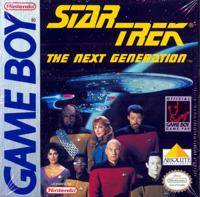software.wikisort.org - Video_game
Star Trek: The Next Generation is a large spaceship simulation video game based on the Star Trek follow-up series of the same name. It was released in 1993 to the North American and European markets for both the Nintendo Entertainment System (NES) and Game Boy.
This article needs additional citations for verification. (July 2008) |
| Star Trek: The Next Generation | |
|---|---|
 North American cover art | |
| Developer(s) | Imagineering Inc.[1] |
| Publisher(s) | Absolute Entertainment |
| Designer(s) | Mark Beardsley Gregory A. Faccone |
| Programmer(s) | Mark Beardsley Roger Amidon (NES) Additional programming: Henry C. Will IV Roger Amidon (Game Boy) Tak Lau (Game Boy) |
| Artist(s) | Daniel Peters (NES) Gregory A. Faccone |
| Composer(s) | Mark Van Hecke |
| Platform(s) | Nintendo Entertainment System, Game Boy |
| Release | Game Boy:
|
| Genre(s) | Large spaceship simulation |
| Mode(s) | Single-player |
Plot
Players take the role of Starfleet cadets participating in a USS Enterprise-D simulation. Taking the place of Captain Jean-Luc Picard, they must embark on a series of mission-based goals and perform many tasks (in the form of mini-games) such as diverting power to shields, Transporter Systems, Navigation, Tactical, and more.[2]
As the player successfully completes missions, they gain rank. Starting the game as an Ensign, the player can be promoted to Lieutenant, Lt. commander, Commander, and finally Captain. Each rank has a specific password the player can input to resume the game at whatever rank the player had previously achieved. Combat missions involve fighting enemies of varying strengths and numbers, with Talarians being the weakest and renegade Klingons being the most difficult (except for the Borg, who only appear in one mission).
Scenarios
At the beginning of each scenario, Captain Picard gives the player a mission, ranging from transporting ambassadors from one planet to another, to destroying Ferengi pirates, to (eventually) destroying a Borg cube.
Reception
The four reviewers of Electronic Gaming Monthly gave the NES version a 6.5 out of 10, describing the graphics as simply average; two of the four felt that the numerous options for controlling the ship's operation, while "nifty", were poorly explained, confusing, and difficult to execute during combat.[3] GamePro cited the same problems, saying the controls offer a wealth of options but are sluggish and frustrating to operate, and the graphics are "clever, but not eye-popping by current standards." They said it is less difficult than the Game Boy original due to the color graphics and larger screen size, but summarized the game as simply a "warm-up" for upcoming Star Trek: The Next Generation games on current generation consoles.[4] A reviewer in Starlog magazine said that both versions of the game "offer hours of entertainment and challenges." It was given a score of seven out of ten.[2]
References
- "Star Trek: The Next Generation Release Information for NES - GameFAQs".
- "Games for "The Next Generation"". Starlog (201): 8. April 1994. Retrieved November 16, 2014.
- "Review Crew: Star Trek: TNG". Electronic Gaming Monthly. No. 51. EGM Media, LLC. October 1993. p. 42.
- "NES ProReview: Star Trek: The Next Generation". GamePro. No. 51. IDG. October 1993. p. 108.
External links
- Star Trek: The Next Generation at MobyGames
- Star Trek: The Next Generation at GameFAQs
Другой контент может иметь иную лицензию. Перед использованием материалов сайта WikiSort.org внимательно изучите правила лицензирования конкретных элементов наполнения сайта.
WikiSort.org - проект по пересортировке и дополнению контента Википедии